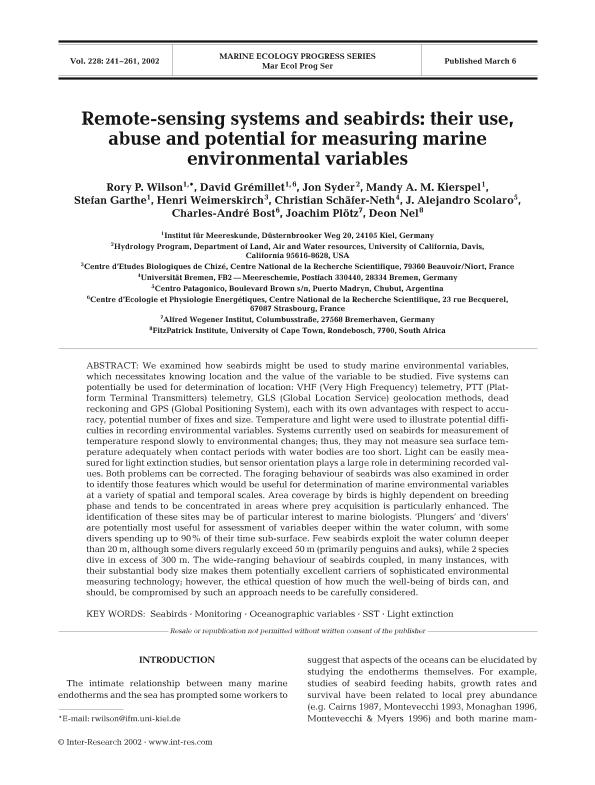Mostrar el registro sencillo del ítem
dc.contributor.author
Wilson, Rory P

dc.contributor.author
Grémillet, David
dc.contributor.author
Syder, Jon
dc.contributor.author
Kierspert, Mandy
dc.contributor.author
Garthe, Stefan
dc.contributor.author
Weimerskirch, Henri
dc.contributor.author
Schafer Neth, Christian
dc.contributor.author
Scolaro, Jose Alejandro

dc.contributor.author
André Bost, Charles
dc.contributor.author
Plotz, Joachim
dc.contributor.author
Nel, Deon
dc.date.available
2020-03-26T19:59:10Z
dc.date.issued
2002-03
dc.identifier.citation
Wilson, Rory P; Grémillet, David; Syder, Jon; Kierspert, Mandy; Garthe, Stefan; et al.; Remote-sensing systems and seabirds: their use, abuse and potential for measuring marine environmental; InterResearch Science Center; Marine Ecology Progress Series; 228; 3-2002; 241-261
dc.identifier.issn
0171-8630
dc.identifier.uri
http://hdl.handle.net/11336/101002
dc.description.abstract
We examined how seabirds might be used to study marine environmental variables, which necessitates knowing location and the value of the variable to be studied. Five systems can potentially be used for determination of location: VHF (Very High Frequency) telemetry, PTT (Platform Terminal Transmitters) telemetry, GLS (Global Location Service) geolocation methods, dead reckoning and GPS (Global Positioning System), each with its own advantages with respect to accuracy, potential number of fixes and size. Temperature and light were used to illustrate potential difficulties in recording environmental variables. Systems currently used on seabirds for measurement of temperature respond slowly to environmental changes; thus, they may not measure sea surface temperature adequately when contact periods with water bodies are too short. Light can be easily measured for light extinction studies, but sensor orientation plays a large role in determining recorded values. Both problems can be corrected. The foraging behaviour of seabirds was also examined in order to identify those features which would be useful for determination of marine environmental variables at a variety of spatial and temporal scales. Area coverage by birds is highly dependent on breeding phase and tends to be concentrated in areas where the prey acquisition is particularly enhanced. The identification of these sites may be of particular interest to marine biologists. ?Plungers?and ?divers? are potentially most useful for assessment of variables deeper within the water column, with some divers spending up to 90% of their time sub-surface. Few seabirds exploit the water column deeper than 20 m, although some divers regularly exceed 50 m (primarily penguins and auks), while 2 species dive in excess of 300 m. The wide-ranging behaviour of seabird coupled, in many instances, with their substantial body size makes them potentially excellent carriers of sophisticated environmental measuring technology; however, the ethical question of how much the well-being of birds can, and should, be compromised by such an approach needs to be carefully considered.
dc.format
application/pdf
dc.language.iso
eng
dc.publisher
InterResearch Science Center
dc.rights
info:eu-repo/semantics/openAccess
dc.rights.uri
https://creativecommons.org/licenses/by-nc-sa/2.5/ar/
dc.subject
SEABIRDS
dc.subject
MONITORING
dc.subject
OCEANOGRAPHIC ECOLOGY
dc.subject
MIGRATION
dc.subject.classification
Ecología

dc.subject.classification
Ciencias Biológicas

dc.subject.classification
CIENCIAS NATURALES Y EXACTAS

dc.title
Remote-sensing systems and seabirds: their use, abuse and potential for measuring marine environmental
dc.type
info:eu-repo/semantics/article
dc.type
info:ar-repo/semantics/artículo
dc.type
info:eu-repo/semantics/publishedVersion
dc.date.updated
2020-02-11T17:56:24Z
dc.journal.number
228
dc.journal.pagination
241-261
dc.journal.pais
Alemania

dc.description.fil
Fil: Wilson, Rory P. Institut fur Meereskunde; Alemania
dc.description.fil
Fil: Grémillet, David. Institut fur Meereskunde; Alemania
dc.description.fil
Fil: Syder, Jon. California State University; Estados Unidos
dc.description.fil
Fil: Kierspert, Mandy. Institut fur Meereskunde; Alemania
dc.description.fil
Fil: Garthe, Stefan. Institut fur Meereskunde; Alemania
dc.description.fil
Fil: Weimerskirch, Henri. Centre National de la Recherche Scientifique; Francia
dc.description.fil
Fil: Schafer Neth, Christian. Centre National de la Recherche Scientifique; Francia
dc.description.fil
Fil: Scolaro, Jose Alejandro. Consejo Nacional de Investigaciones Científicas y Técnicas. Centro Científico Tecnológico Conicet - Centro Nacional Patagónico; Argentina
dc.description.fil
Fil: André Bost, Charles. Centre National de la Recherche Scientifique; Francia
dc.description.fil
Fil: Plotz, Joachim. Alfred Wegener Institute; Alemania
dc.description.fil
Fil: Nel, Deon. University of Cape Town; Sudáfrica
dc.journal.title
Marine Ecology Progress Series

dc.relation.alternativeid
info:eu-repo/semantics/altIdentifier/url/https://www.int-res.com/abstracts/meps/v228/p241-261/
dc.relation.alternativeid
info:eu-repo/semantics/altIdentifier/doi/http://dx.doi.org/10.3354/meps228241
Archivos asociados
